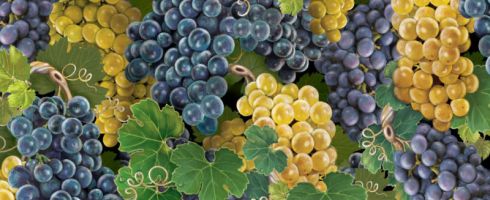All wine lovers are familiar with Chardonnay and Pinot Noir. They’re stars, both in Champagnes and on their own. But Pinot Meunier, well, that’s another story entirely. It’s the overlooked Champagne grape. And while it usually takes just a supporting role, Meunier plays a very important part in Champagnes.
THE GRAPE GROWERS CAN COUNT ON
For one thing, it makes up 32 percent of grapes grown in the region, a bit more than Chardonnay (30 percent), a little less than Pinot Noir (38 percent). Meunier yields more juice than its partners. And it’s a hardy black grape, the only major Champagne grape that ripens in extremely cold seasons. (The Vallée de la Marne, in the northwestern part of Champagne–where most Meunier is grown–tends to be a little cooler than other parts of the region.) Because Meunier buds later than Chardonnay and Pinot Noir, it’s less likely to be affected by early spring frosts. And because it matures faster, it skirts problems with mold and mildew that sometimes follow late season rains. In other words, Meunier is the grape growers can count on.
WHAT THE EXPERTS SAY
Peter Liem, author of ChampagneGuide.net, says this reliability is a huge factor in its importance. But, he adds, “Meunier offers something the other grapes don’t.” In non-vintage wines, that’s “exuberance and fruitiness.” And “when treated seriously and in the right terroir,” Liem continues, “Pinot Meunier produces very high-quality wines. In the past 10 to 15 years, there’s been an explosion of interest among high-quality growers.”
Grower Champagne importer extraordinaire Terry Theise agrees. “Good vine material,” he says, “grown in good vineyards and vinified in a careful–i.e., not slapdash–manner can give excellent results.”
MOUSSE FILS
For the first time, for example, two 100% Meunier Champagnes, which Theise imports–the Spécial Club and the Rosé Spécial Club, both from Moussé Fils–have been featured by the Club Trésors (http://www.clubtresorsdechampagne.com/en). This organization of 28 artisan winemakers is known for high-quality wines from the best areas of the Champagne region. Its Club wines are generally produced from the oldest vines in the finest vineyards.
Winemaker Cédric Moussé, whose family has been cultivating vines since 1750, is one of the early wave of winemakers now celebrating Meunier. Eighty percent of his production is Meunier. Theise describes Moussé’s wines as “highly flavory and loaded with Meunier charm” and elegance. Moussé’s wines often receive excellent reviews. Two that have include the currently available Or d’Eugène Brut NV and the Millesime Terre d’Illite Brut 2012.
MEUNIER FACTS
Meunier means miller in French. Pinot Meunier gets its name because the downy white undersides of its leaves look as if they’ve been dusted with flour.
Meunier is thought to be a genetic mutation of Pinot Noir.
Some consider Meunier to be the least ageworthy of the three major Champagne grapes. That’s why it’s usually found in non-vintage blends–to add youthful accessibility.
When its buds are destroyed, Meunier can produce another batch, thereby recovering as much as 70 percent of its original yield.
Few Grandes Marques–i.e. the major, most prestigious producers–boast of their Meunier with one notable exception: Krug, one of the most prestigious Champagnes of all. It values the spiciness and fruitiness of Meunier.
OTHER MEUNIER PRODUCERS AND ENTHUSIASTS
In 2015 some Meunier producers and advocates founded an association to draw attention to it. Members of the Meunier Institut (https://www.facebook.com/meunierinstitut/) include Champagne Eric Taillet, Champagne Météyer Père et Fils, Champagne Roger-Constant Lemaire, Champagne Serveaux Fils, Champagne Roger Barnier, Champagne Moutardier, Champagne Heucq Père et Fils, Champagne Didier-Ducos, Champagne A. and J. Demière, and consultant oenologist Pierre-Yves Bournerias.
Additional Meunier enthusiasts in Champagne include René Geoffroy, Gaston Chiquet, Chartogne-Taillet, Aubry, Egly-Ouriet, José Michel, Michel Loriot, Laherte Frères, Jérôme Prévost, Françoise Bedel , Déhu Père et Fils, Bérêche & Fils, Dehours et Fils, Lelarge-Pugeot, René Collard, Benoît Tarlant, Franck Pascal and Christophe Mignon.
CHAMPAGNE FACTS
Although most Champagnes are white, they’re made mostly from black grapes that are very lightly pressed.
Meunier is not the least well-known grape in Champagnes. The other approved but truly rare grapes are the white Arbane, Petit Meslier, Pinot Blanc and Fromanteau (aka Pinot Gris)–which together make up less than 0.3% of plantings.

